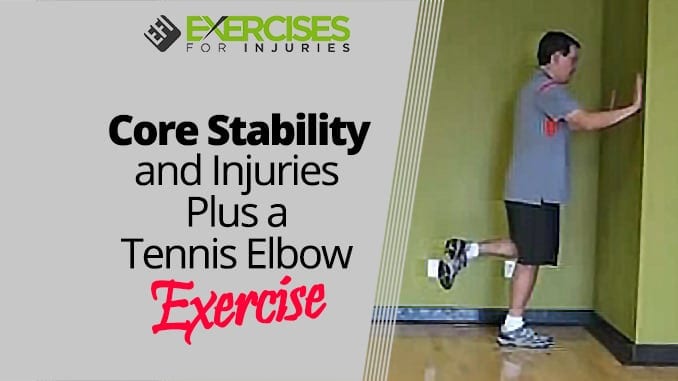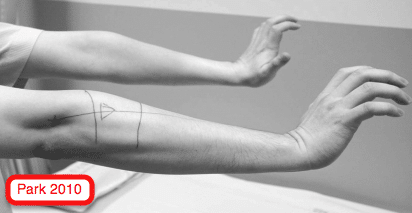
There is always a discussion in the fitness world on the core and if we should focus on it. I know some people will roll their eyes when I talk about core strength. Well, when it comes to injuries, I focus on the core.
It looks like core strength is playing more of a role in injuries. In previous Injuries of the Month (patellofemoral pain syndrome, sacroiliac joint pain, and piriformis syndrome), core stability has been a component of the exercise program that I have recommended.
I wanted to highlight some research that talked about injuries and core strength.
What They Looked At
They looked at 80 female and 60 male intercollegiate basketball and track athletes.
This was very interesting. They calculated core strength by testing:
- Isometric hip abduction strength
- Isometric hip external rotation strength
- Back extensor endurance (modified Beiring-Sorensen test)
- Quadratus lumborum endurance (side bridge test)
Exciting Points in the Introduction
- A drop in lumbo-pelvic (or core) stability has increased lower extremity injuries, especially in females.
- The injuries that females are at greater risk for are: anterior cruciate ligament (ACL) ruptures, patellofemoral pain syndrome, iliotibial band friction syndrome, and stress fractures (femoral, pubic, tibial, and metatarsal).
What They Found
These were the main results of the study:
- Males produced greater hip abduction, external hip rotation, and quadratus lumborum measures
- Athletes who did not sustain an injury were notably stronger in hip abduction and outer cycle
- Hip outer cycle strength was the only useful predictor of injury status
Rick’s Comments
When we focus on working on the core, we often think of crunches or bridge interpretations. Interestingly, this research expands on things further and looks at a core function in different planes of movement and other movements. I like that it highlights the importance of looking at hip abduction and hip outer cycle strength. Many times this is not mentioned or covered in an exercise program.
Here is an exercise that I give to work on hip movement and strength:
A few comments on the practice. The activity can be used for:
- Educating the movement of hip movement from the rest of the body.
- Dynamic stretching of the hip rotators.
- A bodyweight active hip rotator exercise.
The directions are given, and the cueing can change the function of the movement.
Easy and Effective Exercises for Tennis Elbow
I am working on this month’s Injury of the Month. It is Tennis Elbow.
I was researching the injury and came across this article, which was interesting. It talks about isometrics for an injury and emphasizes the new trend in exercise rehabilitation.
What They Looked At
They wanted to see if isometric exercises were as practical as medication for pain relief in those with lateral epicondylitis (tennis elbow).
They had two groups:
- Group 1 – They were shown the exercise, and then they did it at home
- Group 2 – Began the practice after four weeks of medication
Exciting Points in the Introduction
- An increase in symptoms from exercise will lower the compliance rate to the exercise program.
- Performing the exercises too aggressively can increase the risk of disorder or injury.
- The above two points are obvious, but nice to see them highlighted in an article.
Tennis Elbow Exercise Performed
The researchers only gave one exercise. Here are the details of the exercise:
- The subjects did the exercise sitting or standing with their arms flexed to just below shoulder height. The focus was on moving the middle finger towards the elbow to target the extensor carpi radialis brevis. Then the wrists were carried in a slow controlled manner into extension with the fingers relaxed.
- The exercise was executed without pain and in a controlled manner.
- Four sets of 50 repetitions, each duplication held for 10 seconds, are done daily.
What they Found
- After one month, group 1 had a more significant drop in their pain levels compared to group 2
- There was no difference between the groups at 3, 6, and 12 months follow-up.
- Those that did not feel any benefit from the exercise program after one month were referred to shock wave therapy
Rick’s Comment
Interesting to see the benefits of isometric strengthening on an injury, specifically with lateral epicondylitis. Isometric exercises are not exciting but effective for an injury and are the safest of the three types of contractions.
A lot of the research focuses on eccentric exercises for the tennis elbow. This article highlighted the benefits of an isometric exercise, which is less stressful on an injured area.
The number of repetitions was a surprise to me. Over a day performing 200 repetitions or about 33 minutes of exercise sounds like a lot. This is a trend that is occurring in exercise rehabilitation. Standardizing at 1 set of 10 repetitions is fading away and does not correlate well with what many people do during the day (number of movement cycles performed in a day). Performing low load (isometrics) more often transfers what one does daily and assists in recovery.
So that you know, the tennis elbow exercise program will be coming out at the end of the month. That is it for another edition of the research review. I hope this helps you with core strength and injuries, plus an excellent tennis elbow exercise.
Rick Kaselj, MS





